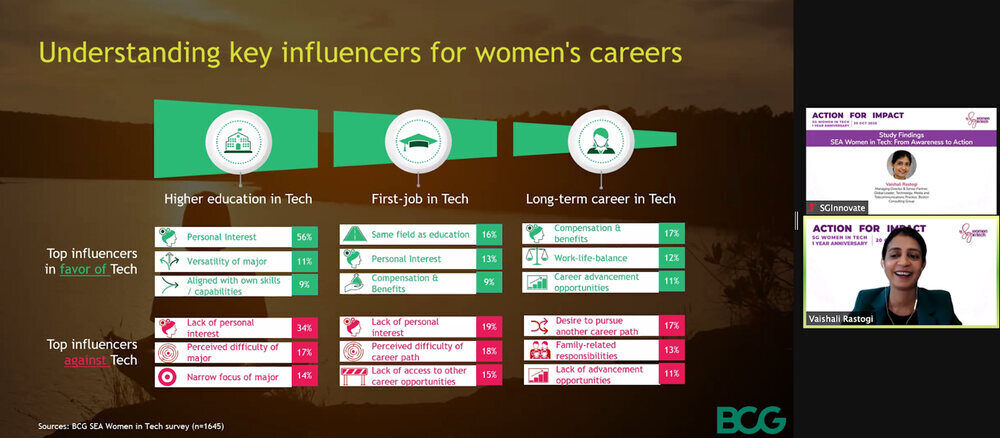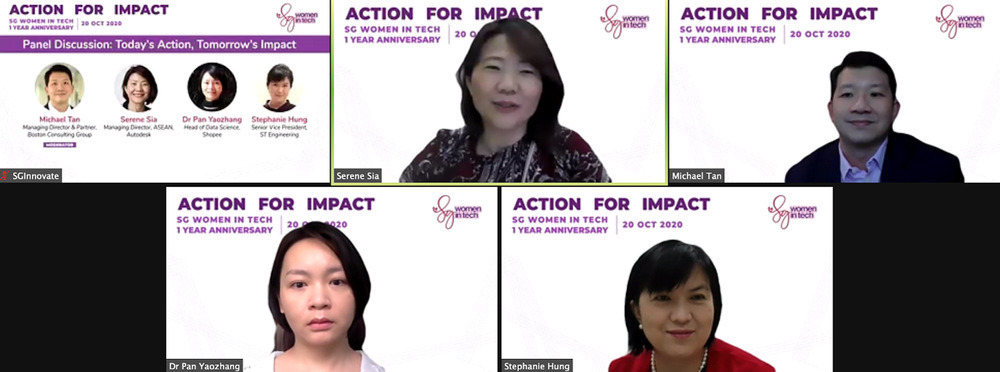
By Kami Navarro
With the rise of digitalisation, there’s been an increasing spotlight on women in tech—or more specifically, the lack thereof. Year after year, various reports and white papers call attention to tech’s gender gap. And yet, discourse surrounding women in Southeast Asia’s burgeoning tech landscape is noticeably absent.
Seizing the opportunity to fill this gap, Boston Consulting Group (BCG) recently partnered with the Infocomm Media Development Authority (IMDA) to study gender diversity in tech in the region, identifying common issues and proposing solutions in the process. The report’s findings were tackled at the recent Singapore Women in Tech (SGWIT) anniversary webinar on 20 October 2020, alongside a related panel featuring some of Singapore’s female tech trailblazers. IMPact News brings you key highlights from these two sessions.
The three moments of truth
Covering around 1,650 female respondents in six Southeast Asian countries, the report found that women’s participation in tech across the region was higher than the global average—including mature Western markets like the US and UK. While these numbers are highly encouraging, there’s still room for improvement.
No matter which country you look at, there is leakage everywhere.
Ms Vaishali Rastogi
Managing Director and Senior Partner at BCG
“We start off with fairly significant numbers, but as we go further and reach CEO and board-level positions, the numbers drop to the 15 percent range.” Hence, action must be taken to retain women throughout every step of their tech careers.

The report identified three critical junctures or “moments of truth” that disproportionately influence the decision of women to pursue and stay in tech. The first moment of truth arises when women choose what to study in college. For many young girls, a lack of familiarity with the field’s career options, as well as the perception that tech was “difficult” prevented them from taking up tech degrees.
The next moment of truth then comes when women decide on their first jobs. Interestingly, Ms Rastogi and her co-authors found that the choice of first job was greatly influenced by their educational degrees—highlighting the importance of attracting girls to pursue tech during university. The decision to remain in tech long-term then comprises the final moment of truth. According to the report, work-life flexibility as well as attractive opportunities for career advancement and learning boost retention among women.
“Now that we know what influences women in each moment of truth, we can now have a targeted set of actions,” said Ms Rastogi. One surprising strategy is having institutions publicly commit to gender diversity. By doing so, women see that institutions are serious about bringing them in. Another strategy would be having role models. “It gives women the confidence to see that there is a pathway to the top,” she added.
Empathy for equality
Though the BCG report sets the scene for gender diversity in Southeast Asia’s tech landscape, there are country-specific nuances that must also be considered. How, then, can Singapore improve women representation in tech? This was the question posed by Mr Michael Tan, Managing Director and Partner at BCG to panellists during the webinar.

For Ms Serene Sia, ASEAN Managing Director at Autodesk, it’s high time to take a closer look at company recruiting practices. “People tend to recommend others like themselves,” she explained. “When left unchecked, the hiring manager could miss out on many highly qualified candidates.”
Ms Sia’s sentiment is shared by Shopee’s Head of Data Science Dr Pan Yaozhang. With her background in artificial intelligence, Dr Pan has witnessed firsthand how a biased dataset can unfairly skew outcomes. “If your network is 70 to 80 percent male, how can you fairly evaluate the value of different genders?” she said. Therefore, it’s crucial for companies to intentionally set inclusive policies. “This applies not just to the hiring process, but also in the everyday work environment by allowing female employees to feel valued.”
The entire workplace experience therefore has to be designed with empathy, noted Ms Stephanie Hung, Senior Vice President at ST Engineering. In line with BCG’s findings, understanding the key life stages that women in tech go through could make all the difference. In fact, as a mentor in SGWIT’s MentorConnect programme, Ms Hung shared that there were many moments of “reverse” mentoring. “I can learn from younger generations of women leaders to deal with situations differently,” she added.
As emphasised in the BCG report, achieving gender diversity is the rare solution that benefits everyone.
For tech companies, it means more talent. For women, it means more opportunities in a fast-growing and interesting workplace of tech.
Ms Vaishali Rastogi
Managing Director and Senior Partner at BCG


.webp)